Are you looking for Teachable alternatives?
I know, Teachable recently increased their subscription costs and replaced their unlimited courses feature with only 1 course on their beginner plan (thanks to theiracquisition by Hotmart), that too with 7.5% transaction fee.
And what about existing customers?
Held for ransom!
As someone who is into online course creation and has experimented with all the major LMS and community platforms:
In this blog post I will introduce you some reliable and trustworthy alternatives to Teachable.
Here’s a quick overview:
| All-in-one platform | Community feature | Mobile apps | Starting price | |
| Thinkific | No | Limited | Yes (iOS & Android) | $49/month |
| Kajabi | Yes (Truly) | Yes | Yes (iOS & Android) | $89/month |
| Podia | Yes | Yes (Limited) | No | $39/month |
| Circle | Yes (Partially) | Yes | Yes (iOS & Android) | $89/month |
| LearnWorlds | No | Yes | Yes (add-on) | $29/month |
Thinkific – Superior customization and design options
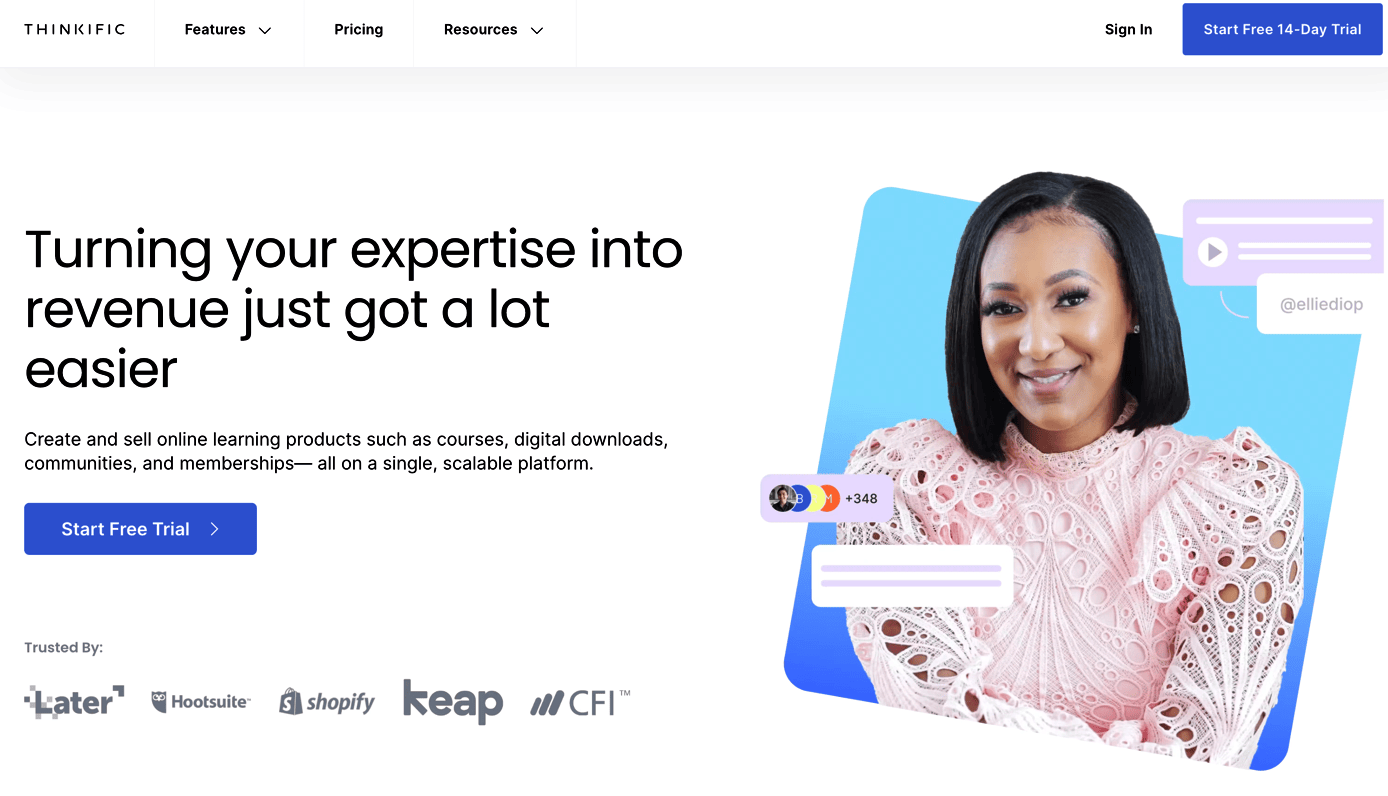
Thinkific is a great alternative to Teachable for those who are interested only in a course platform but not an all-in-one platform.
Similar to Teachable, you can create your online courses and also create membership sites with Thinkific.
While traditionally Thinkific was more limited in terms of features, they have recently rolled out a lot of advanced functionalities such as student-level analytics, video retention reports, and coaching features.
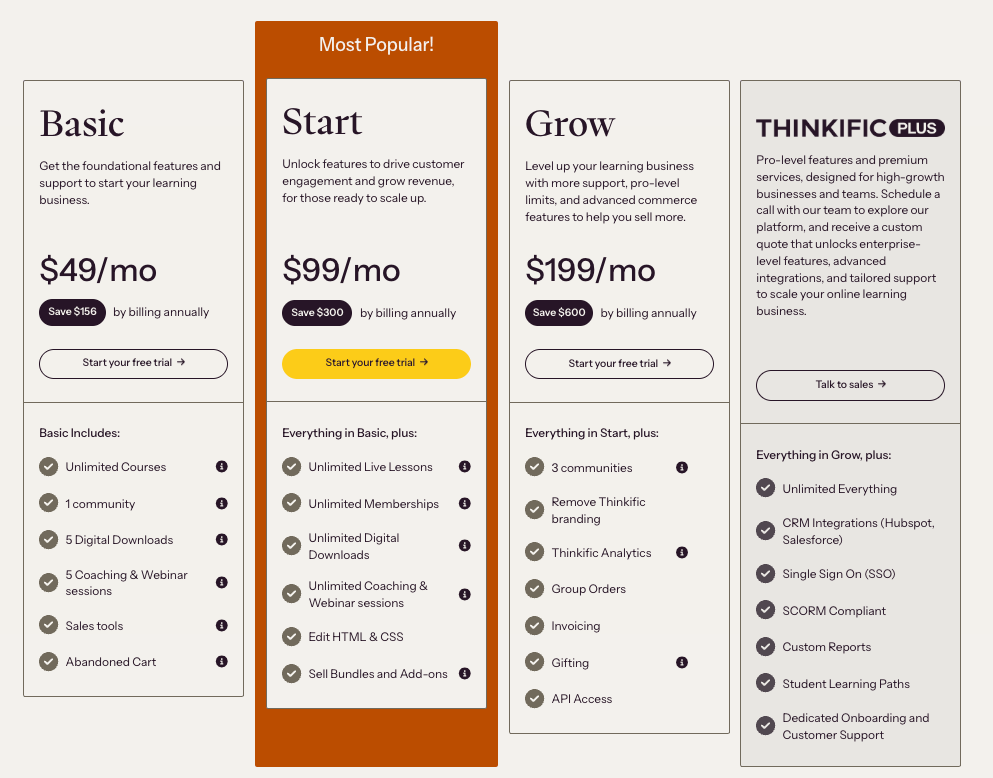
Thinkific delivers exceptional value with its $49/month basic plan offering unlimited courses and zero transaction fees, making it ideal for course creators who want room to scale.
While Teachable’s $39/month plan might seem cheaper upfront, it severely restricts you to just 1 published course and takes 7.5% of every sale – meaning you’d pay $75 on a $1,000 course sale.
Pros 👍
- Mobile accessibility: Has a mobile app for both Android & iOS users (Teachable only has iOS).
- Superior design options: Thinkific has better design and customization options than Teachable, with presets and themes.
- No-code website building: Its site builder lets you create great designs without coding.
- Built-in community: It comes with a community feature (but limited).
- Custom branding: Unlike Teachable, Thinkific allows you to remove their branding from login and sales page URLs.
Cons 👎
- Interface issues (not a big deal): Their user interface needs work. They should fix the padding and spacing of elements on the screen.
- Limited marketing tools: Since it’s not an all-in-one platform, you don’t get email marketing features (unlike Podia and Kajabi).
I have tried and tested Thinkific, and in fact, I have published a detailed review on my blog previously.
Or if you are interested in how Teachable and Thinkific compare, refer to this blog post.
🏆 Bottomline: Thinkific offers all the features of Teachable, along with mobile apps for both Android and iOS. If you like Teachable but shying away due to their recent issues, Thinkific may be the perfect choice for you.
Kajabi – All-in-one platform with automation

Kajabi is a more all-in-one digital selling platform.
It comes with features like:
- Online courses (as feature-rich as Teachable!)
- Community (with gamification)
- Memberships
- Digital products
- Email marketing
- Marketing automation
- Kajabi Events (Webinars)
The best part is that all these features work in tight integration with each other, with an automation layer on top giving rise to a lot of creative marketing use cases.
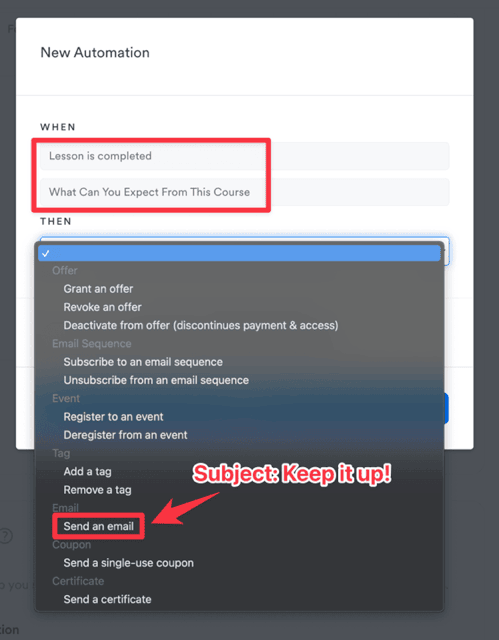
For instance, above you can see how their course feature integrates with their email marketing feature. Whenever a lesson is completed, you can trigger a specific email, or even register them for an event or a webinar, as you can see.
Kajabi is an all-in-one platform, but what’s really impressive is how deep its features go.
For instance:
- Their course platform packs advanced compliance tools, student-level video tracking, heat maps, and quiz features that cover all your bases.
- The community feature isn’t basic – it comes with gamification and powerful automation to keep members engaged.
- You get a built-in funnel builder that works just like ClickFunnels, right inside the platform.
- Their automation system connects everything together with custom triggers and actions that make marketing a breeze.
Right now, Kajabi is valued at around $2 billion with big funding across multiple rounds.
And they keep rolling out new features faster than most platforms out there.
However, Kajabi is a premium platform.

Its Basic plan starts at $149/month, it may initially appear more expensive.
However, it replaces tools like:
- Community platforms like Circle.so ($89/month)
- Email marketing tools like ConvertKit (approximately $200/month for a 25k contacts)
- Website hosts (around $20/month for decent hosting)
- Webinar platforms like Zoom Webinars or Demio (starting at $59/month)
Pros 👍
- Powerful automation: Advanced automation that connects courses, funnels, and communities with each other.
- Community features: Includes feature-rich community with gamification elements (they recently acquired Vibely)
- Email marketing: Built-in email marketing means you don’t need a separate tool.
- Product selling: Lets you sell digital products easily.
- Website builder: Comes with a website builder that has conversion-focused blocks.
- Mobile accessibility: Has both iOS and Android apps with really good user experience.
Cons 👎
- Product limitations: Their Basic plan (at $149/month) only allows 3 Products, pushing you to their pricier $197/month plan.
- Premium pricing: It costs more than other platforms, which might be a deal breaker if you’re looking for something cheaper.
👉 If you want to know more about the advanced features of Kajabi, you can read my complete review.
🏆 Bottomline: Kajabi is the best all-in-one platform I can recommend. They offer a range of features that tightly integrate with each other and their features has good depth.
Podia – Affordable all-in-one platform

Podia stands out as an excellent all-in-one platform similar to Kajabi.
What makes it special?
It has a clean, minimal interface and offers:
- Online courses: With drip content, bundles, upselling, quizzes, and Zapier integration.
- Coaching: Sell sessions with calendar app integrations.
- Digital downloads: Perfect for upselling opportunities.
- Webinars: Host via Zoom or YouTube Live.
- Community: Basic forum-style features with topic creation and content restrictions.
- Email marketing: Includes broadcasts, drip campaigns, templates, and basic automation.
Here’s the catch – while Podia packs many features, they don’t go as deep as premium alternatives.
For example:
- The website builder is basic (essentially a storefront) with no custom CSS options.
- Community features are limited to forum-style functionality.
- It’s missing advanced analytics and student retention reports available in the top platforms.
Now about pricing.
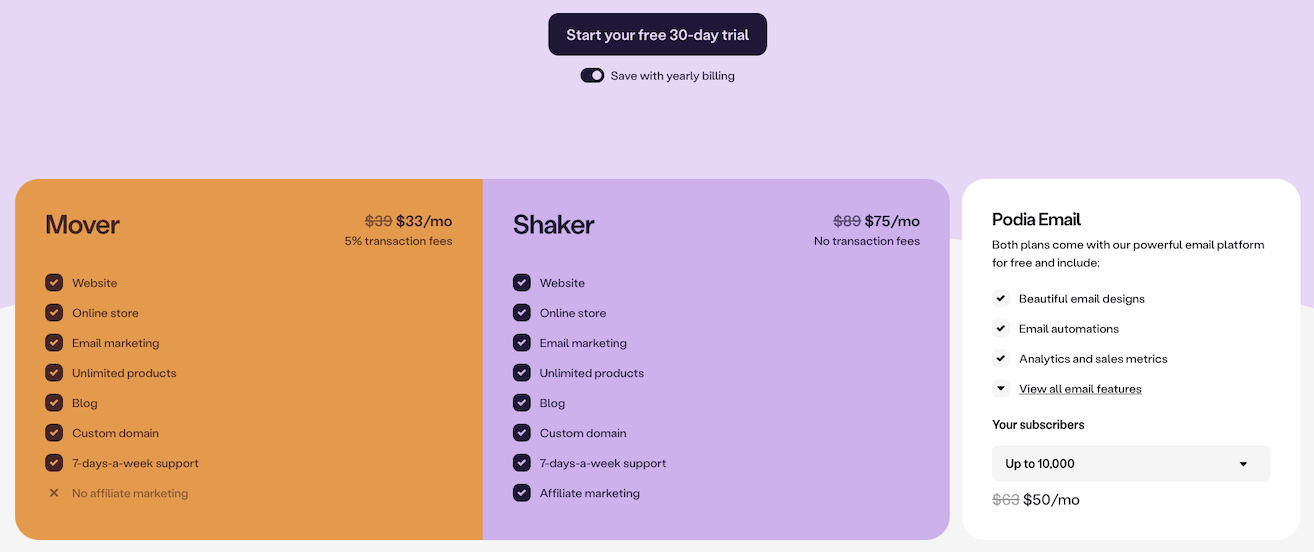
Podia’s Mover plan at $39/month offers great value for beginners with unlimited courses, downloads, and coaching capabilities.
While the 5% transaction fee might seem steep.
For more established creators, the Shaker plan at $89/month eliminates transaction fees completely and introduces powerful affiliate marketing tools.
This plan represents the sweet spot for serious course creators!
Pros 👍
- Good user experience: The interface is clean and easy to use, with nice attention to detail
- All-in-one solution: It brings together multiple tools in one place, but the features aren’t as deep as what you’d get with specialized platforms
- No content limits: You can create unlimited courses and products with no storage or bandwidth restrictions
- Digital product selling: You can sell digital products easily and even embed checkouts on your site! (Makes it a good alternative to Gumroad)
Cons 👎
- Features lack depth: The features lack depth. For instance, you can’t find in-depth assessments and student-level reporting features that you find in other specialist tools.
- Mobile limitations: There’s no mobile app available
You can refer to my complete review on Podia if you want more information.
🏆 Bottomline: Although Podia is an all-in-one platform, it lacks depth. You may feel like it’s a jack of all trades. It does not offer features such as superior course compliance and in-depth reporting. However, if you need access to a light-weight community, digital product selling, and superior email marketing features, you cannot go wrong with Podia.
Circle – Community-centric alternative
Circle is a community-focused course platform launched in 2019 by Sid Yadav, Teachable’s first designer.
It has strong backing from Teachable founder Ankur Nagpal, who put 90% of his liquid net-worth into the platform.
What makes Circle stand out?

Its clean, intuitive UI/UX that borrows the best elements from successful startups like Slack and Notion.
Just like Notion, Circle gives you building blocks to create your online community exactly how you want it.
Right now, they’re mainly focused on improving courses and email marketing features (rolling out advanced features).
Circle comes with mobile apps, built-in live streaming, and smart automation workflows that work similar to Zapier for your community.
👉 They’ve also added “Community AI” features that help you manage your community better and make it more engaging with gamification elements.
Now, pricing:
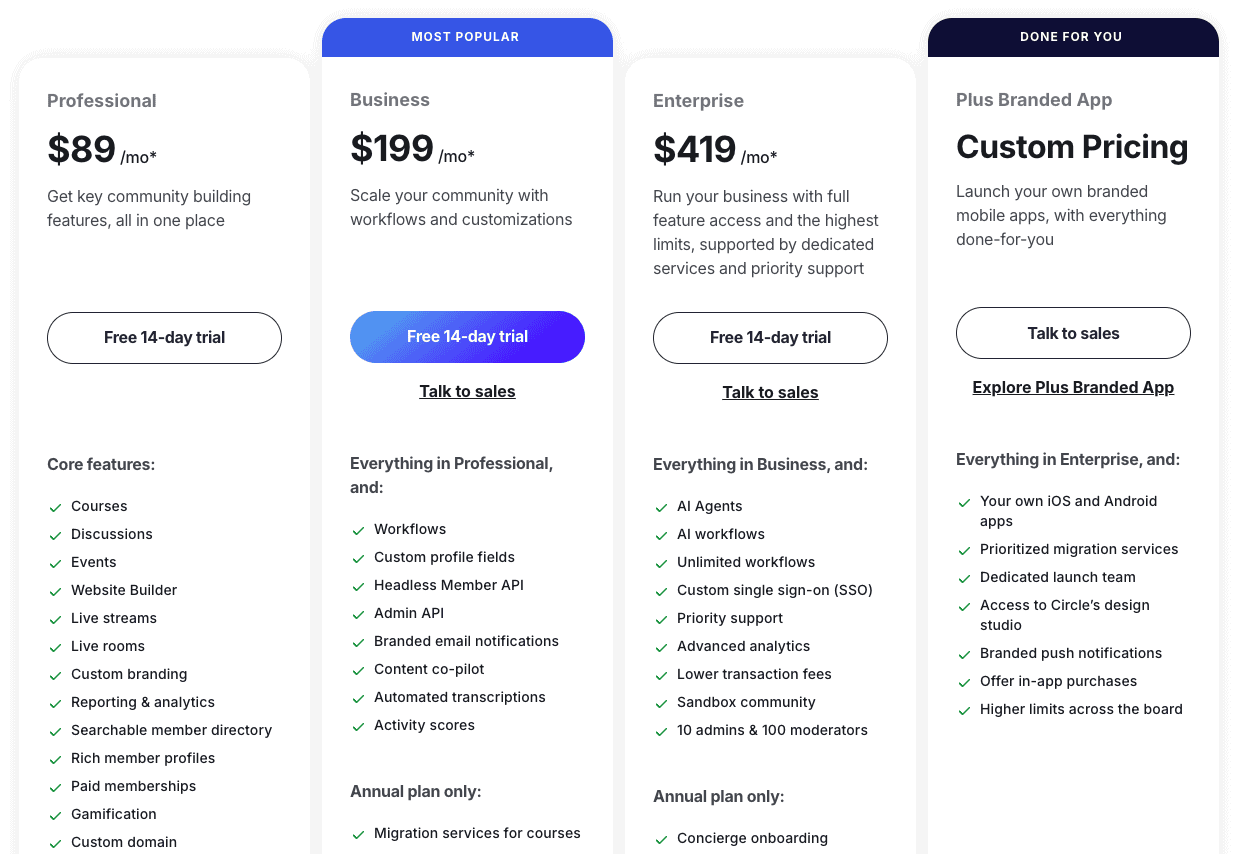
For most people, the Professional plan at $89 per month is ideal, but the Business plan at $199 per month offers a lot more features.
The most notable being “Workflows” that help you set triggers and actions within the Circle platform, similar to Zapier.
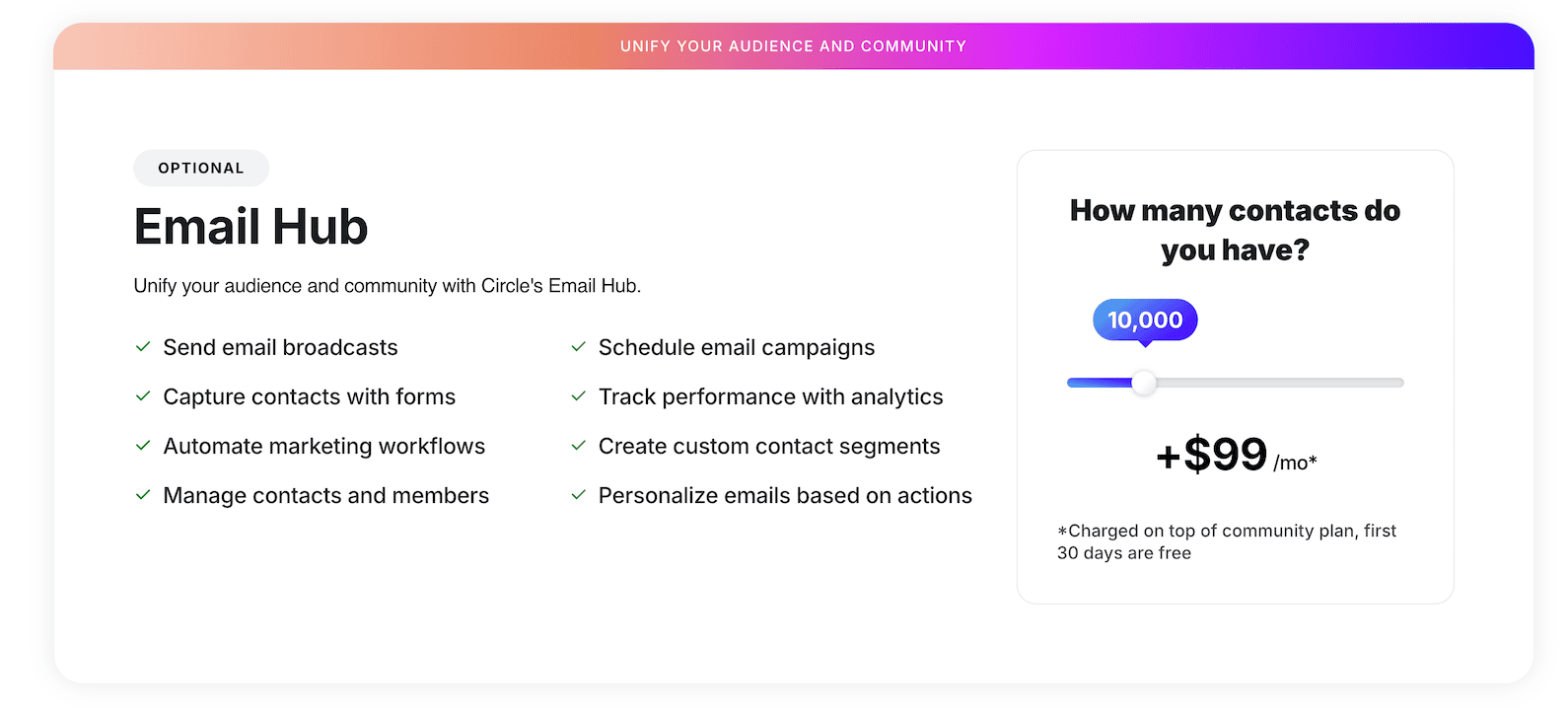
Circle now includes email marketing features as part of their goal to become an all-in-one platform.
They offer basic email campaigns, automated sequences, and subscriber management.
Though not as robust as dedicated email platforms, it’s convenient for community managers wanting integrated solutions.
Things to watch out for:
- All their plans are billed annually (look for the asterisk * in the pricing).
- They don’t show the transaction fee on their pricing page.
- They don’t clearly mention how many workflows you actually get with their Business plan.
Pros 👍
- User experience: The UI is super clean and easy to use. Both you and your members will find it a breeze to navigate around.
- Feature development: They roll out new features quickly, so you’ll always have the latest tools at your fingertips.
- Workflow automation: It comes with automation tools (similar to Zapier) that make managing your community much easier.
- AI capabilities: Their Community AI features help boost engagement and give you smart tools to manage everything better.
Cons 👎
- Feature limitations: It’s missing some specialized course features right now, which might be a problem if you’re an advanced course creator.
- Premium cost: The price tag is pretty steep, making it tough for beginners or smaller communities to justify the cost.
🏆 Bottomline: If you are looking for a food community centric platform with really good flexibility, then you need to go with Circle. It is backed by the former team of Teachable!
LearnWorlds – Best for academics
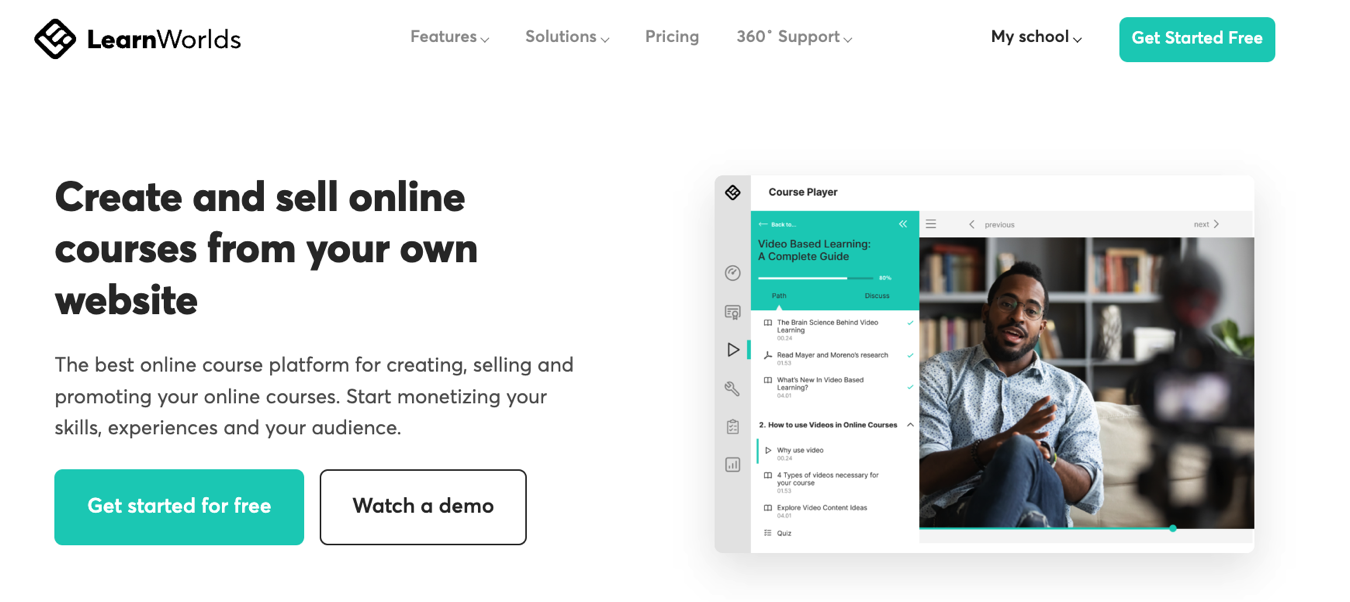
LearnWorlds stands out as a solid Teachable alternative, especially if you’re creating academic courses.
It comes with some unique features like:
- Interactive videos
- Transcripts
- SCORM and HTML5 support
- Powerful website builder
Some of these features like “interactive videos”, come in their learning center plan, which costs $249/month.
Here’s the catch – despite all these rich features, the interface feels cluttered and the user experience needs serious improvement.
They keep adding new features like pop-up builder, advanced page builder, and even an ebook creator. But honestly, they should focus on making the core experience better instead of piling on more features.
If you prefer clean, easy-to-use interfaces, LearnWorlds might drive you crazy.
Now.
If you’re more focused on marketing your courses rather than needing technical features like interactive videos, SCORM, and HTML5 support, you should probably look elsewhere.
Let’s look at pricing.
- Starter plan ($29/mo): Perfect for beginners or micro-schools on a budget, but comes with a 5% transaction fee on every sale.
- Pro Trainer plan ($99/mo): No transaction fees! It also unlocks memberships, subscriptions, and better engagement tools. Great for full-time course creators or small teaching teams.
- Learning Center plan ($299/mo): Get complete white-label control, AI video features, deep analytics and smart automations. It’s ideal for growing online academies.
Almost all the exclusive features of LearnWorlds are available only in their Learning Center plan.
🏆 Bottomline: If you’re into academic courses, then LearnWorlds’ unique features like interactive videos, advanced assessments, and features like SCORMs and HTML5 may be useful for you.
LearnDash – Best WordPress LMS
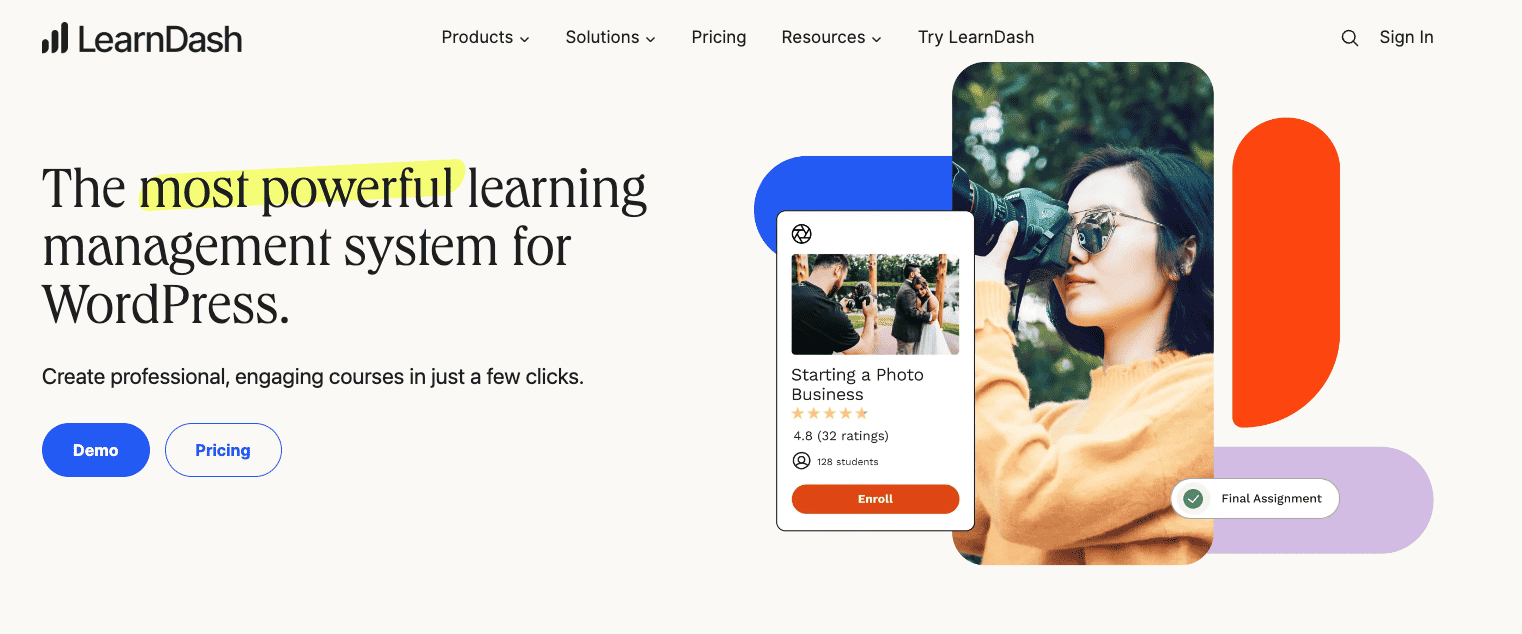
LearnDash stands out as a WordPress-based solution. If you’re already comfortable with WordPress, it’s worth considering.
Its key features include:
- Online courses
- Quizzes
- Memberships
- Propanel – Student level analytics
LearnDash offers numerous free, premium, and 3rd party addons.
It also integrates seamlessly with popular WordPress plugins like WooCommerce, Elementor, Gamipress and many more.
I personally host some of my older courses on LearnDash. You can read my detailed review here.
From my experience, LearnDash outperforms all other WordPress LMS plugins with its superior integrations, reliability, and add-ons.
👉 If you’re familiar with WordPress, LearnDash gives you flexibility to leverage your development team and bring creative ideas to life. As a WordPress plugin, it offers customization and the ability to create unique learning experiences through custom development.
The catch?
You need solid WordPress knowledge, and without a developer, setting up LearnDash can be quite challenging.
But the possibilities are endless.
Pricing is based on site licenses.
- For 1 site – $199/year.
- For 10 sites – $399/year.
- For unlimited sites – $799/year.
It’s a one-time purchase, but you’ll need to pay for ongoing updates and support.
🏆 Bottomline: Despite this, LearnDash is a cost-effective and flexible solution if you’re into online courses. Its pricing starts at $199/year for 1 site license, and its technical support is good.
FreshLearn – Best freemium platform

With FreshLearn, you can either create on-demand or cohort courses.
When creating course lessons, it supports various content types:
- Text
- Images
- Audio/video
- Attachments
- Quizzes & assessments
Also, similar to Teachable and Thinkific, it supports course completion certificates and content dripping.
One unique feature of FreshLearn is that it includes gamification features, such as the ability to assign points, rewards, and host challenges based on actions taken within the community.
However, as of now, it lacks leaderboards and badges.
The best part is that FreshLearn has mobile apps for both iOS and Android users, which is quite impressive.
FreshLearn is a freemium platform, making it super accessible to get started.
Its Pro plan starts at $49/mo and packs a punch with courses, communities, assessments, and even an AI website builder.
For those wanting more advanced features, the No Brainer plan at $79/mo gives you advanced theme customization, mobile apps, question banks, custom themes, and completely removes FreshLearn branding.
It’s the perfect choice if you’re serious about creating a professional learning experience.
🏆 Bottomline: FreshLearn is a good alternative to Teachable and is quite affordable with unique gamification features.
Teachery

Let’s talk about Teachery as a course platform option.
Here’s something important to know right away: Teachery doesn’t handle video hosting. You’ll need to use YouTube, Vimeo, or Wistia instead.
It has some serious limitations compared to Teachable or Thinkific.
What’s missing?
It doesn’t have superior course compliance, quizzes, certificates, discussions, a native payment gateway, and several other important features.
Where does Teachery shine?
- Simple pricing. They offer just one pricing plan (monthly or yearly options) that includes all features. No need to compare complex tiers or packages.
- Unlimited courses, lessons, and students. You can create as many courses and lessons as you want, and manage any number of students without restrictions.
Teachery costs $39/month with annual billing. But considering you’ll need to handle video hosting separately, this price tag feels a bit steep.
🏆 Bottomline: Teachery, a “Lite” version of Teachable, but it lacks memberships, in-depth reporting, and certain marketing features, but offers an affordable, satisfactory solution.
Bottomline
In summary, if you’re seeking a robust Teachable alternative without its downsides, consider Thinkific.
If you prefer an all-in-one platform to avoid purchasing separate products for your online business, Kajabi is a good choice. Despite being an all-in-one platform, it offers many specialized features.
If Kajabi’s $199 per month is too steep, consider Podia. It’s also an all-in-one platform but is quite affordable without product creation limits, but while its features lack depth, it still offers nearly everything you need.
These are my top three picks.







